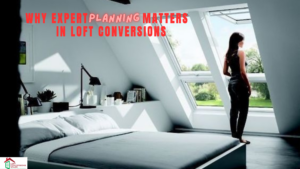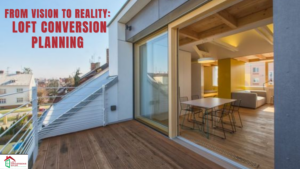When you’re lucky enough to live in the historic Cardiff Bay area key role, it’s crucial to preserve your home’s architectural beauty and heritage while still making improvements for modern living and wider community. One way to achieve this is through a loft conversion that adds value and space to your home and respects the original architecture on station road. With careful planning and attention to detail, you can create a stunning new space that seamlessly blends with your home’s rich history key role.
Before embarking on your loft conversion journey on construction teams, it’s essential to understand the architectural history of Cardiff Bay and how it influences design considerations for any new additions or alterations Building Fabric.
This article will walk you through the benefits of loft conversions in this unique area, guide planning construction teams, design considerations, and hiring professionals, and showcase successful examples from other Cardiff Bay homeowners who have successfully navigated this process on station road and Key role.
Understanding the Architectural History of Cardiff Bay on Construction Teams
You’ve got to appreciate the rich architectural history of Cardiff Bay key role, as it plays a crucial role in preserving heritage and enhancing homes through loft conversions and Building Fabric.
Cardiff Bay’s transformation from a small seaside village into an industrial powerhouse has left its mark on the area’s architecture and Building fabric. The Industrial Revolution brought significant changes to the landscape, with numerous docks and associated infrastructure being built to support the growing coal and iron trade. This industrial influence is evident in many buildings still standing today, reflecting a range of architectural styles, including Victorian, Neo-Gothic, and terraced housing.
When considering a loft conversion Station Road in this historic area, it’s essential to approach the project to the original architecture. Many homes Station Road in Cardiff Bay boast unique features such as bay windows and building Fabrics, ornate cornices, and intricate brickwork that should be preserved during renovation work.
By considering these elements when planning your loft conversion, you can ensure that your project not only enhances your home but also preserves and celebrates Cardiff Bay’s rich architectural heritage and residential development.
Benefits of Loft Conversions in Cardiff Bay and East Quay
Discover the benefits of loft conversions in Cardiff Bay. You’ll enjoy increased living space, added property value, and the satisfaction of maintaining the area’s rich architectural heritage.
With careful planning and design, your home can blend seamlessly with its historic surroundings while providing a comfortable and functional living environment. Embrace the opportunity to enhance your home while preserving Cardiff Bay’s unique character and East Quay charm.
Increased living space
Expanding your home’s square footage with a loft conversion provides enhanced living space and an opportunity to preserve the rich heritage of Cardiff Bay Original Buildings. Loft aesthetics and space optimization are vital when planning your loft conversion in this historic Residential development development area. Combining contemporary design with traditional features allows you to create a unique space that respects the area’s history and meets your modern-day needs Residential development.
1. **Preserving original architectural features**: Emphasize retaining and restoring elements such as exposed wooden beams, brickwork, or wrought ironwork. This will allow you to maintain the historical charm while enhancing functionality.
2. **Incorporating natural light**: Strategically plan for windows or skylights that complement existing structures without disrupting the historic facade. Adding natural light will make your new living space more spacious and inviting.
3. **Merging old and new styles**: Opt for a design approach that harmoniously blends modern materials with classic finishes, ensuring your loft conversion is an extension of the existing aesthetic rather than a jarring contrast.
By thoughtfully considering these factors during your loft conversion process, you’ll create an increased living space that pays tribute to Cardiff Bay’s vibrant past while offering all the comforts of contemporary living.
Added property value
Not only will you enjoy the benefits of a larger living space, but your property’s value could significantly increase with a carefully planned loft conversion that respects the area’s history and charm.
Property investment in the historic Cardiff Bay area is all about maximizing value while preserving heritage. By undertaking a loft conversion that adheres to local regulations and architectural guidelines, you can ensure that your home retains its character and becomes even more desirable to potential buyers.
When planning your loft conversion, it’s essential to consider how the design can enhance the property’s functionality and aesthetics while remaining respectful of its original architecture.
This might involve using reclaimed materials or matching existing fixtures and fittings to maintain consistency throughout your home. By prioritizing historical accuracy during your renovation, you’re investing in long-term value maximization for your property.
You’re ensuring that it remains an attractive prospect for future owners who appreciate the rich history of Cardiff Bay.
Maintaining the area’s heritage
By carefully considering your loft conversion’s design, you’re playing a crucial role in maintaining the unique character and charm that makes this area particular while adding value to your property.
Heritage conservation is essential in preserving the historical authenticity of Cardiff Bay, which boasts an impressive array of Victorian and Edwardian architecture. When planning your loft conversion, it’s crucial to consider the original design elements of your home and surrounding buildings, ensuring that any modifications are sympathetic to their historical context. This includes paying close attention to features such as rooflines, windows, and materials used.
To successfully balance modern functionality and historical authenticity, consult with experienced architects or designers with a proven track record in working with heritage properties. They can provide valuable guidance on how best to incorporate contemporary amenities while respecting the original architectural style of your home.
Additionally, be sure to familiarise yourself with local planning regulations and seek approval from relevant authorities if necessary – adhering strictly to these guidelines will ensure that any alterations made contribute positively to preserving the distinctive appeal of Cardiff Bay for generations to come.
Planning and Design Considerations
Transforming your attic into a stunning living space in Cardiff Bay’s historic area requires thoughtful planning and design considerations to blend modern amenities seamlessly with yesteryear’s charm.
Historic preservation and adaptive reuse are essential elements to consider during the planning stages, as they ensure that the character and integrity of your home remain intact while making it more functional for contemporary living. This involves working with architects and builders who have experience converting lofts within historic buildings and consulting with local authorities to ensure any proposed alterations comply with conservation area guidelines.
When designing your loft conversion, consider your home’s existing architectural features, such as ornate cornices, original floorboards or exposed beams. Retaining these features helps maintain the building’s historic character while adding a unique charm to your new living space.
Ensure that any new materials used complement those already present in the building—for example, if you’re replacing windows or doors, opt for styles that match the originals closely. Additionally, consider how you can incorporate energy-efficient solutions like insulation and double-glazed windows without compromising aesthetics.
By carefully considering these factors during the planning stage, you’ll be better equipped to create a stylish yet sympathetic loft conversion that enhances your home and Cardiff Bay’s rich heritage.
Hiring the Right Professionals
It’s vital to engage experienced and reliable professionals when undertaking a loft conversion in a historic building, as they’ll have the expertise necessary to ensure your project is successful and compliant with local regulations. Historic preservation is paramount when working in Cardiff Bay’s heritage properties, so you need professionals who understand the significance of preserving original architectural features while creating sustainable conversions.
1. Look for an architect or designer who specializes in historic buildings. They’ll be familiar with these unique structures’ planning processes and design considerations.
2. Choose a contractor with proven experience working on heritage properties, as they’ll be skilled at using traditional techniques and materials essential for maintaining the building’s historical integrity.
3. Consult a structural engineer who has knowledge of older construction methods and can assess the potential impact of your proposed conversion on the existing structure.
4. Seek advice from a heritage consultant if your property is listed or located within a conservation area, as they can guide you through any additional planning permissions or restrictions that may apply.
By assembling this team of experts, you can ensure your loft conversion adds value and functionality to your home, respects its architectural history, and contributes positively to Cardiff Bay’s rich cultural landscape.
Successful Loft Conversion Examples in Cardiff Bay
You’ll find inspiration in the numerous successful loft conversion projects throughout Cardiff Bay that showcase a perfect blend of modern living and preserved historical charm. These conversions exemplify Cardiff’s creativity, combining contemporary design with respect for the area’s rich history.
Many homeowners have been able to enhance their homes while maintaining the unique character of their properties, drawing from local architectural styles such as Victorian terraces and Edwardian-era designs. By collaborating with skilled professionals who understand the importance of preserving heritage, these individuals have achieved stunning results that pay tribute to Cardiff Bay’s past while welcoming its future.
In your search for Bay inspiration, note how these successful conversions use original features like exposed beams and brickwork, incorporating them into new designs that reflect the homeowner’s personal style. Blending modern elements with historic details creates a harmonious, visually appealing and functional balance.
With careful planning, you can achieve this delicate fusion in your loft conversion project. As you explore different options for your home, remember to consider not only your immediate needs but also how your decisions will impact your property’s overall aesthetic appeal and integrity within its historical context.
Frequently Asked Questions
What are the common challenges faced during loft conversions in the Cardiff Bay area historic buildings?
When converting lofts in historic Cardiff Bay buildings, you’ll face structural challenges and material selection issues. Maintaining historical accuracy, respecting the original architecture, and paying attention to details is crucial.
How can one ensure that the loft conversion is in harmony with the building’s existing architectural style and heritage?
To ensure architectural harmony and heritage preservation, consult an architect experienced in historic buildings. Carefully plan your loft conversion to respect original features, materials, and proportions while enhancing functionality.
Are there any specific regulations or guidelines to follow when undertaking a loft conversion project in a historic Cardiff Bay property?
To ensure historic preservation, follow local architectural guidelines for loft conversions in Cardiff Bay. Consult with planning authorities and heritage organizations for specific regulations on maintaining the area’s historic integrity.
What are some innovative ways to incorporate modern amenities and technology into a loft conversion while preserving the historic character of the building?
Incorporate innovative materials and adaptive reuse in your loft conversion to preserve historic character. Integrate modern amenities subtly, respecting original architecture while updating spaces for comfort and functionality.
Are there any grants or funding opportunities available for homeowners looking to undertake a loft conversion in a historic Cardiff Bay property?
Yes, explore historic preservation incentives and adaptive reuse possibilities for funding. Grants may be available through local councils, heritage organizations, or government schemes to support your loft conversion in a historic Cardiff Bay property.
You’ve now gained insight into the rich architectural history of Cardiff Bay and the benefits of loft conversions in this area. It’s essential to consider planning, designing, and hiring the right professionals to ensure your project is historically accurate and respectful of the original architecture.
With careful planning and execution, you can transform your home while preserving its heritage. Cardiff Bay offers numerous examples of well-executed loft conversions that enhance homes without compromising their historic charm.


